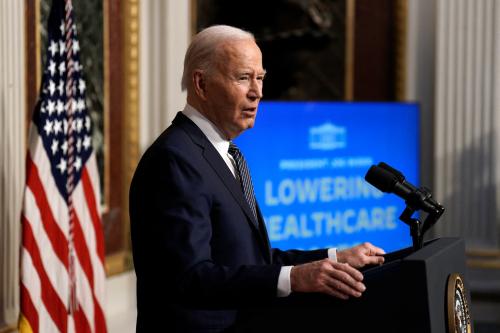Introduction
Health insurance coverage remains an important issue for millions of Americans. Numerous reforms have contributed to important gains in health coverage in the U.S. In 2022, 91.8% of all residents in the U.S. reported having some form of health insurance.1 Among working-age adults only, 88.4% reported having some form of health insurance. However, 23 million working-age adults in the U.S. were still uninsured as of 2022 with most being low-and-middle income earners, people of color, or noncitizens.2
A large body of research demonstrates that gains in health coverage are important for both individuals and the public at-large. Health insurance provides essential financial protection in the face of both routine health care and catastrophic health events. The uninsured are more likely to delay or forgo necessary health care altogether. In 2022, 22% of uninsured non-elderly adults went without needed care because of cost compared to only 4.7% of those with private coverage and 7.4% of those with public coverage, according to KFF analysis of survey data. When injured or ill individuals without health insurance manage to receive health care, those costs are passed onto taxpayers, private insurers, and health care providers, straining budgets and costing tens of billions of dollars each year.
The following issue brief considers the health coverage landscape in the U.S. We begin by summarizing major health reforms over the past century, including the Affordable Care Act (ACA). We then examine the effect of the ACA and pandemic-era policies on insurance rates. We subsequently hone in on remaining gaps in coverage, largely among noncitizen populations and in states that have yet to expand Medicaid. We conclude by considering policy pathways that continue to lower the national uninsurance rate.
A brief history of major health insurance reforms in the U.S.
The first half of the 20th century saw a rise in employer-sponsored coverage, however, by 1950, older individuals who were retired, disabled, and experiencing poverty found it increasingly difficult to obtain affordable coverage.3 By the time President Lyndon B. Johnson was elected in 1964, the political environment was ripe for action on health reform, and the President made health coverage for older adults his top priority. Meanwhile in Congress, Chairman Wilbur Mills of Arkansas championed an expansion of the earlier Kerr-Mills program, which provided health services to the medically indigent elderly, to fill gaps in coverage for welfare beneficiaries. In July 1965, President Johnson signed the Medicare and Medicaid Act (also known as the Social Security Amendments of 1965) into law. This law established the Medicare program (Title 18), which provided nearly universal health insurance for persons ages 65 and older, and the Medicaid program (Title 19), which provided health insurance for people experiencing poverty through joint state and federal financing. In 1997, the Children’s Health Insurance Program (CHIP) was signed into law to provide health insurance to kids whose families have incomes too high to qualify for Medicaid, but too low to afford private coverage. Medicare, Medicaid, and CHIP endure as among the most important social programs in the country and cover millions of Americans. However, because of eligibility requirements, Medicaid is the only public health insurance program that serves low-income adults without disabilities ages 18-64.
From December 2007 to June 2009, the U.S. experienced the Great Recession, and the resulting economic downturn contributed to an increased uninsured population among working-age adults which grew from 56.4 million in 2008 to 59.1 million in the first quarter of 2010. Against this backdrop, the Patient Protection and Affordable Care Act, signed into law in 2010 and fully implemented in 2014, was intended to usher in the most substantial changes to the U.S. health-care system since Johnson’s reforms nearly a half-century earlier. The ACA, as it is frequently called, sought to make affordable private health insurance accessible to more American adults, expand the Medicaid program, regulate the insurance market, and provide special protections for adults under age 26 and those with preexisting conditions. The ACA also sought to promote care delivery models that lower the costs of health care; however, this aspect of the law is outside the scope of this paper.
The ACA played an important role in substantially increasing access to coverage
The ACA implemented several reforms to improve access to insurance coverage, however, in this section we highlight the impact of expanded Medicaid eligibility and the federal Marketplace subsidies as the two main pathways through which the ACA improved coverage rates. However, evidence shows that provisions such as the extended dependent-coverage for those ages 19-25 played an important role in reducing the uninsurance rate for the young-adult population.
Analyses of coverage rates have found that since its implementation, provisions in the ACA interacted to cut the uninsurance rate by nearly half. Survey data from the American Community Survey (ACS) shows that the uninsurance rate among working-age adults has decreased from 20.8% in 2013 to 11.6% in 2022.4 However, when considering only citizens ages 18-64, the decline in uninsurance rates has been more dramatic with uninsurance rates falling from 17.8% to 9.5% between 2013 and 2022.
Figure 1 illustrates the declining uninsurance rate since 2008, distinguishing between states which did and did not expand Medicaid. It should be noted that, following the Great Recession, the economy improved substantially, and then experienced another shock in 2020 due to the COVID-19 pandemic. Our analysis of the ACS should be interpreted with the broader economic picture in mind. Both expansion and non-expansion states saw reductions in the uninsurance rate after the passage of the ACA. Reductions in the uninsurance rate among the nonelderly began in 2010 and continued trending downward in subsequent years. A large share of the impact of Medicaid expansion was due to the welcome-mat effect: after Medicaid was expanded, individuals who were already eligible for Medicaid (in both expansion and non-expansion states) enrolled due to increased information and outreach. However, the change in the uninsurance rate before and after the implementation of the ACA was larger among expansion states.5 Uninsurance rates in expansion states between 2013 and 2022 decreased 31% (1.8 percentage points) more than rates of uninsurance in non-expansion states during that same time period.6 This finding highlights the role of Medicaid expansion specifically in reducing uninsurance rates.
While Medicaid expansion benefits Americans in aggregate, our analysis of ACS data and other evaluations of the ACA have shown that expansion has had larger effects for racial and ethnic minorities. ACS data shows that Black and Hispanic individuals living in expansion states both saw about a 39% larger decrease between 2013-2022 compared to those living in non-expansion states.7 While white individuals also saw an impact from Medicaid expansion, the effect was larger for Black and Hispanic Americans, providing some evidence that expansion played a role in reducing racial disparities in health coverage.8 Similarly, Medicaid expansion helped to reduce disparities in coverage between low- and high-income households. Those earning less than 138% of the federal poverty line (FPL) in expansion states, the new eligibility limit for Medicaid, saw larger declines in uninsurance after Medicaid expansion compared to those in expansion states earning above 138% of the FPL.9 A large body of literature has also identified several other populations that saw large benefits from Medicaid expansion including the near elderly, LGBTQ+ individuals, people experiencing unemployment, people experiencing homelessness, those with complex medical conditions, those with mental health conditions, and rural residents. Finally, beyond increasing access to insurance coverage, several studies have found that Medicaid expansion has contributed to improved access to care. Medicaid expansion is associated with improvements in having a usual source of care, usage of a primary care physician, and declines in reliance on emergency medicine departments as a primary source of care, as well as reductions in annual out-of-pocket spending of more than 10% of an individual’s income.
In addition to Medicaid expansion, the ACA Marketplaces also played an important role in increasing coverage and access to care. Since their implementation in 2014, administrative data show that enrollment in the Marketplaces has nearly tripled, growing from 8 million individuals to more than 21 million individuals in 2024, with Black and Hispanic individuals seeing the largest growth in enrollment. Evaluations of the Marketplaces, although more difficult to study due to their national roll-out, have demonstrated their role in improving nation-wide coverage rates. A year-one difference-in-difference analysis compared uninsured and employer-insured individuals earning between 138%-400% of the FPL and identified about an 11-percentage point increase in insurance coverage for the previously uninsured population after 2014. Longer-run analyses reaffirm that the Marketplaces decreased uninsurance rates, although the estimated effect on coverage is smaller in part due to policies implemented after 2017, such as the elimination of the cost-sharing reduction subsidies, which diluted the impacts of the Marketplaces. Survey data through 2018 provides some evidence that enrollment in the Marketplaces also helped to reduce racial disparities in private insurance take up among those eligible for the subsidies. For those who received coverage through the Marketplaces, coverage was then associated with improvements in access to necessary care, prescription drugs, diagnoses, and reports of excellent health.
In summary, the ACA had a profound impact on access to health insurance. Both Medicaid expansion and the insurance Marketplaces have played a vital role in reducing uninsurance rates both at the national level and for under resourced populations.
Recent policies have advanced coverage gains made under the ACA
Since the enactment of the ACA, a number of more recent policies have bolstered the impact of the law for low- and middle-income families. In response to the COVID-19 pandemic, Congress passed the American Rescue Plan Act (ARPA) in 2021 to provide additional financial assistance to people purchasing coverage in the ACA Marketplaces. ARPA expanded financial help available to people already eligible for federal premium subsidies, and it extended eligibility for such subsidies to people with incomes over 400% FPL, a group that previously did not qualify for financial assistance but were often priced out of the Marketplaces. Importantly, ARPA caps premiums for Marketplace health plans at 8.5% of a household’s family income, based on the cost of a benchmark plan.
These subsidies smoothed what was referred to as the subsidy cliff: when individuals earning just above 400% of the FPL would see outsized increases in their health insurance premium as a share of income. The Inflation Reduction Act (IRA), passed in 2022, then extended the more generous premium subsidies until 2025. Due to the extended subsidies, an estimated four in five people purchasing Marketplace plans were able to find coverage for $10 or less per month for plan year 2024, according to the Department of Health and Human Services. Moreover, estimates by KFF show nearly 5 million people who are uninsured qualify for free or nearly free premium plans in the ACA Marketplace under the expanded subsidies.10
The aforementioned policies have created an important safety net for certain people during the unwinding of the pandemic-era Medicaid continuous enrollment provision, which prohibited states from disenrolling individuals from Medicaid in exchange for an increase in federal funding. Beginning in March 2023, states reviewed the eligibility of people enrolled in the program and removed them if they were no longer eligible or did not complete the renewal process. As of July 2024, roughly 24 million people have been disenrolled from Medicaid since the beginning of the unwinding, with the majority being disenrolled for procedural reasons, though it should be noted that early analysis shows that the net disenrollment rate was higher for children than adults nationwide.
For those who are not eligible for public coverage and for whom employer-sponsored coverage is not affordable or available, purchasing a plan on the ACA Marketplaces may offer an affordable path to quality health coverage, in large part due to the expanded financial relief and premium subsidy eligibility provisions of ARPA and IRA. Recent analysis by the Georgetown Center on Children and Families demonstrated that marketplace enrollment among those disenrolled from Medicaid more than doubled (118%) in November 2023 compared with October 2023.11 Further analysis of enrollment data over time, specifically for adults ages 18-64, is needed to determine the relationship between the Marketplaces and Medicaid unwinding, though it appears that the availability of low-deductible ACA Marketplace plans may soften the blow of losing Medicaid coverage for low-income individuals in states that have not expanded Medicaid.
While the coverage landscape remains complex, governmental policies and programs continue to provide important relief for millions of Americans.
Citizens in expansion states have high rates of coverage, but more can be done for noncitizens and those living in non-expansion states
While the U.S. has made substantial progress in reducing the uninsurance rate, 11.6% (about 23 million individuals) of working-age adults residing in the U.S. remain uninsured. Moreover, the uninsurance rate varies substantially by citizenship status and residency. The uninsurance rate for working-age citizens living in Medicaid expansion states is 7.2%, which is nearly 40% lower than the national uninsurance rate.12 However, in practice, this figure may even be somewhat lower. If an uninsured individual below 138% of the FPL in an expansion state incurs large medical expenses, the hospital or physician’s office at which they received treatment would assist them in enrolling in Medicaid. Thus, this subset of uninsured individuals are effectively covered by Medicaid even though they are not officially enrolled in the program. If considering this caveat, the uninsurance rate for working-age citizens in Medicaid expansion states is 5.1% (56% lower than the national uninsurance rate).13
Yet, when considering the non-expansion and noncitizen population, there remain high rates of uninsurance.14 First, ACS data also shows that the uninsurance rate in non-expansion states is 26% higher than the national average.15 Among citizens only, 14.6% of working-age adults in non-expansion states are uninsured compared to only 7.2% of working-age adults in expansion states. Across all racial, age, and income groups, individuals in non-expansion states are currently about two times more likely to be uninsured compared to those in expansion states. Second, ACS data shows the uninsurance rate among noncitizens is nearly 3.5 times higher than among citizens at 32.9%. While the ACS does not differentiate noncitizens by their immigration status, data from a KFF/LA Times survey demonstrates the heterogeneity in coverage for different groups by immigration and citizenship status. It found that, as of 2023, “half (50%) of likely undocumented immigrant adults and one in five (18%) lawfully present immigrant adults report being uninsured compared to less than one in ten naturalized citizen (6%) and U.S.-born citizen (8%) adults.”
Five years after receiving “qualified” status, noncitizens are generally eligible for Medicaid and CHIP. Lawfully present immigrants can also purchase insurance from the Marketplaces. On the other hand, undocumented immigrants are not eligible to purchase insurance on the Marketplaces or qualify for coverage through Medicaid, CHIP, or Medicare. Moreover, noncitizens are less likely to have access to employer-sponsored coverage as many work in jobs that do not provide health benefits. Notably, both lawfully present immigrants and undocumented immigrants face barriers to coverage including confusion about eligibility, language barriers, and a chilling effect associated with revealing one’s immigration status. While cost is often cited as a concern in reference to providing noncitizens with coverage, some evidence demonstrates that public insurance provision to immigrants costs the U.S. health care system less than half of the corresponding cost per year for U.S.-born adults. There are some reasons to be optimistic: slow progress is being made in the coverage of noncitizens, primarily at the state level, in addition to some proposed legislation by Congress and piecemeal executive action.16
Several policy options are available to achieve and sustain increased coverage
Despite progress that has enhanced coverage, there remain high rates of uninsurance, especially among certain communities of color, noncitizens, and people living in states that have not expanded Medicaid. We highlight several policies available in the toolbox that could improve access to health coverage.
Extend ARPA subsidies past 2025
As discussed in previous sections, the ARPA expanded the Marketplace subsidies to above 400% of the FPL and increased the subsidization rate for those earning between 100-400% of the FPL. While the IRA extended the subsidies until the end of 2025, policymakers could consider expanding the subsidies permanently. The Congressional Budget Office (CBO) estimates that this could increase the federal deficit by about $250 billion over a ten-year period. CBO estimates that the increased spending would be largely driven by new enrollees attracted to the Marketplace due to the generous subsidies. Alternative proposals for a more progressive formula that targets benefits to those earning between 100%-300% of the FPL may lower the expected costs of a permanent expansion while still supporting more vulnerable Americans.
Expand Medicaid or address Marketplace coverage gap
The ten remaining holdout states should expand Medicaid. The research literature has long established that Medicaid expansion significantly lowers the uninsurance rate and improves access to health care among low-income populations. However, in the holdout states, significant political and ideological barriers remain. If Medicaid expansion cannot be achieved, policymakers could address the lack of health coverage for nearly 1.5 million people in the so-called coverage gap. This gap includes individuals with incomes above their state’s Medicaid eligibility threshold but below the federal poverty line, making them ineligible to receive subsidies for Marketplace plans, since those subsidies start at the federal poverty level. The coverage gap disproportionately affects people of color and people living in the South.
There are a number of policy proposals that aim to address the coverage gap. For example, federal policymakers could expand eligibility for Marketplace premium subsidies to those with incomes below poverty who are currently ineligible for Medicaid. This Marketplace-based approach would also seek to make coverage for individuals with incomes below 138% of the federal poverty line more similar to Medicaid coverage and, according to CBO estimates, would increase federal spending by $57 billion over the next 10 years. Another approach is the creation of a federal Medicaid program that operates in non-expansion states, where benefits would largely be similar to Medicaid coverage in terms of eligibility, covered services, and beneficiary cost sharing. CBO estimates that a federal Medicaid program would increase federal deficits by $323.1 billion over a decade. Careful consideration of the tradeoffs between these two policy options is required.
Reinstate an uninsurance penalty
The ACA originally required that all Americans enroll in health insurance or pay a tax penalty that, at its highest in 2016, started at $695 annually and increased with income and family size. The individual mandate was designed to encourage those with low health care costs to purchase insurance because, first, everyone should have access to the protection provided by insurance coverage, and second, adding low-cost beneficiaries to the insurance pool lowers average claims spending ultimately helping to stabilize the insurance market. National and state-level evaluations of the individual mandate have found that it was effective in decreasing uninsurance rates while also increasing enrollment in the individual markets particularly among those with income above 400% of the FPL.
However, in the 2017 Tax Cuts and Jobs Act, the tax amount was reduced to $0, effectively eliminating the penalty altogether. Following the elimination of the mandate, a 2018 CBO report projected that 6 million more people would be uninsured primarily due to the elimination of the insurance mandate. Similarly, a 2018 report from the Commonwealth Fund projected that at least 2.8 million fewer individuals would be enrolled in insurance, while premiums for bronze plans would increase by 3-13%. However, evidence from 2019, one year after the elimination went into effect, is less definitive with some studies finding coverage decreased while others found no effect. Ultimately, while continued research is necessary, it is clear that during its implementation, the insurance mandate was able to effectively target populations which tended to forgo insurance. Policymakers could consider increasing the tax amount to re-establish the penalty and, additionally, implementing an alternative penalty scheme to reduce the burden of the tax on low-income families and simplify the penalty structure.
Improve Medicaid outreach and enrollment strategies
Despite improvements in coverage, Black and Hispanic individuals remain approximately half as likely to be covered compared to white individuals regardless of the state they live in.17 Racial disparities in coverage cannot be addressed by Medicaid expansion alone and instead require more targeted efforts to enroll hard-to-reach communities. The navigator program allowed community-based organizations to provide one-on-one consumer support and assistance for those eligible for the federally-facilitated Marketplaces, Medicaid, or CHIP. Following cuts to the navigator program during the Trump administration, a study using administrative data found no significant reductions in Marketplace coverage overall or Medicaid enrollment, but there were significant decreases in overall insurance coverage among certain populations: adults under age 45, Hispanic adults, and adults who speak a language other than English, largely due to decreased Marketplace enrollment. Continued funding for the program is valuable as navigators are uniquely positioned to respond to community needs via hyper-targeted outreach and customized materials.
In addition to improved outreach, individuals on Medicaid should be guaranteed coverage for at least a year after enrollment. Several analyses show that 12-month continuous eligibility policies can reduce Medicaid disenrollment and decrease national churn rates. Currently, Medicaid enrollees must report any circumstantial changes that could affect their eligibility, and while some obtain other insurance, many simply become uninsured and re-enroll within a year. In 2024, Congress established new rules that mandated 12-month continuous coverage for all children in Medicaid and CHIP, thus ensuring 12 months of uninterrupted health coverage regardless of eligibility shifts. States can request a waiver to extend continuous coverage to adults, but this is not mandatory nor widely used, with only 3 states having instituted continuous coverage for adults. Notably, to promote maternal health and increase stable coverage among new mothers, states can extend Medicaid postpartum coverage for 12 months through a state plan amendment. Many states have found this coverage extension desirable, with 49 states including DC having an approved or pending extension as of July 2024. Should 12-month continuous coverage for all adults be adopted by all states, nearly 500,000 more adults would be enrolled in Medicaid in an average month, leading to net savings of $1.8 billion across all payers. Adopting continuous coverage for all adults could provide essential protections to Medicaid enrollees, particularly for Black and Hispanic adults who are more likely to be enrolled in Medicaid already.
Conclusion
Over the past century, the health insurance landscape has changed drastically, and coverage rates have significantly improved. The ACA has contributed to important progress in enhancing insurance coverage in the U.S. Policies such as Medicaid expansion, the Marketplaces, and improved regulation of insurance markets have all intersected, with other factors, to cut the national uninsurance rate in half. Moreover, legislation passed during the COVID-19 pandemic bolstered the impacts of the ACA to further reduce rates of uninsurance. Working-age citizens in expansion states have benefited the most from these coverage gains and are the most likely to have access to health insurance. Ultimately, under the ACA provisions and the tax subsidy schedule existing in 2022, all citizens in Medicaid expansion states have access to affordable health coverage, although some of this coverage in the marketplace involves considerable cost sharing. Alternatively, noncitizens and those living in states that have not expanded Medicaid continue to have rates of uninsurance higher than the national average.
Ultimately, we conclude with an overview of four approaches to address ongoing gaps in insurance coverage: extending the ARPA subsidies past 2025, expanding Medicaid in all 50 states or addressing the Marketplace coverage gap, reinstating a penalty for not having insurance, and improved outreach and enrollment strategies. These steps could further help more people in the United States secure the vital financial protection and increased access to health care that health insurance offers.
Appendix
-
Acknowledgements and disclosures
The authors thank Richard Frank for comments on an earlier draft of this brief. They also thank Yuv Sachdeva and Paris Rich Bingham for excellent research assistance.
The Brookings Institution is financed through the support of a diverse array of foundations, corporations, governments, individuals, as well as an endowment. A list of donors can be found in our annual reports published online here. The findings, interpretations, and conclusions in this report are solely those of its author(s) and are not influenced by any donation.
-
Footnotes
- See Appendix C.
- See Appendix B.
- For a complete discussion of the history of health care reforms in the 20th century, please see Catherine Hoffman, National Health Insurance: A Brief History of Reform Efforts in the U.S., KFF, March 2009. https://www.kff.org/wp-content/uploads/2013/01/7871.pdf
- Authors’ calculations and Appendix B.
- We identify 12 states as being non-expansion states: Alabama, Florida, Georgia, Kansas, Mississippi, North Carolina, South Carolina, South Dakota, Tennessee, Texas, Wisconsin, and Wyoming. North Carolina and South Dakota expanded Medicaid in 2023, but because our survey data only extends to 2022, we classify them as non-expansion.
- See Appendix A; Authors’ calculation.
- See Appendix A.
- See Appendix A and Baumgartner, J., Collins, S., Radley, D., & Hayes, S. (2020, January 16). How the Affordable Care Act Has Narrowed Racial and Ethnic Disparities in Access to Health Care. Commonwealth Fund. https://doi.org/10.26099/kx4k-y932
- See Appendix A and Lin, Y., Monnette, A., & Shi, L. (2021). Effects of Medicaid expansion on poverty disparities in health insurance coverage. International Journal for Equity in Health, 20(1), 171. https://doi.org/10.1186/s12939-021-01486-3
- Plans that are “nearly free” may include cases where some individuals must pay for the non-essential part of their premiums.
- November 2023 was the start of the 2024 Open Enrollment period.
- See Appendix B.
- Authors’ calculation using Appendix B.
- See Appendix B.
- See Appendix B.
- For an in-depth discussion of state-led initiatives to expand health coverage for noncitizens, see Heyison and Gonzales, “States Are Providing Affordable Health Coverage to People Barred From Certain Health Programs Due to Immigration Status,” Center on Budget and Policy Priorities, 2024. https://www.cbpp.org/research/immigration/states-are-providing-affordable-health-coverage-to-people-barred-from-certain
- See Appendix B.





